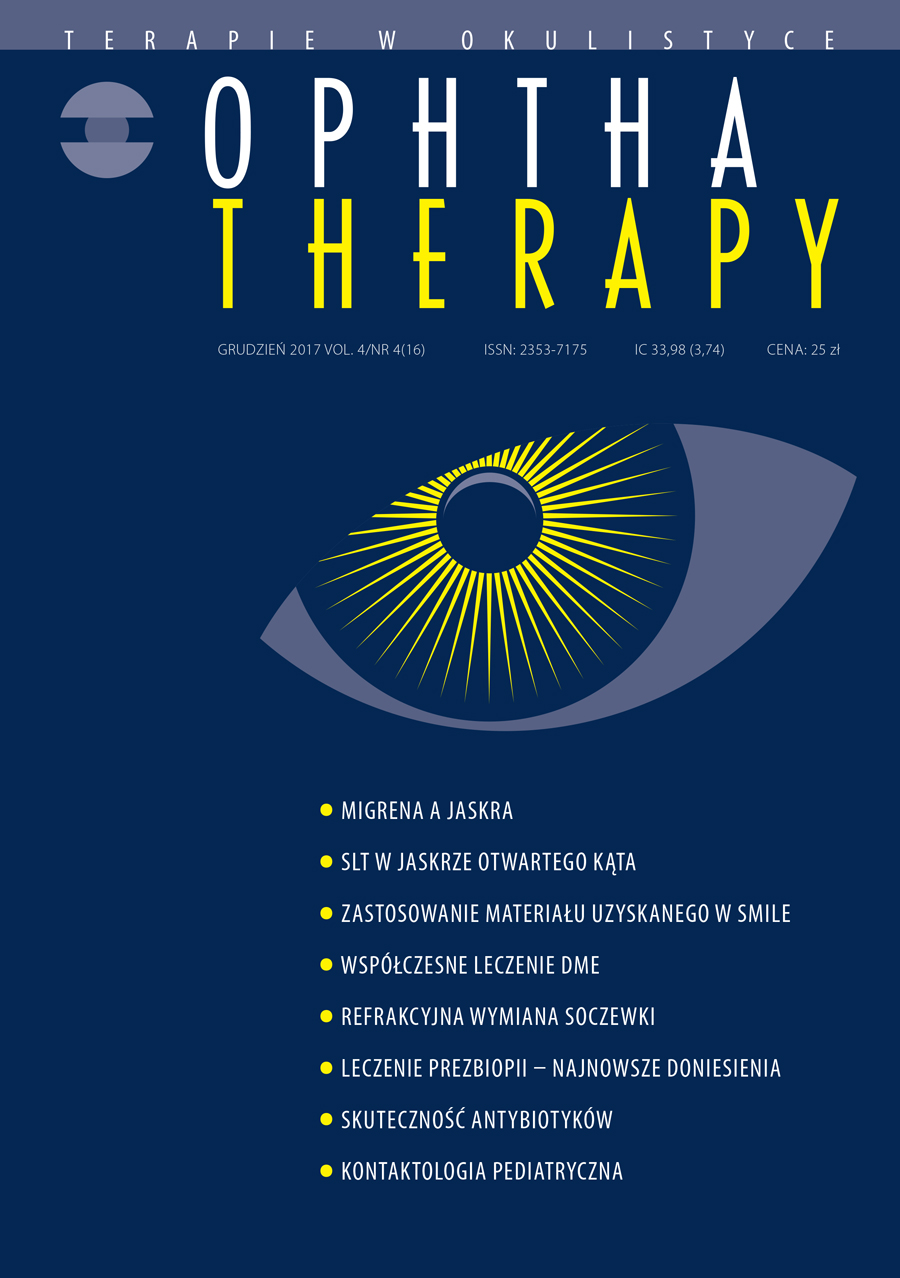Current treatment of diabetic macular edema
Main Article Content
Abstract
Diabetic macular edema is one of the most serious ocular complications in diabetes. At present, several forms of therapy are available that are used depending on the severity of the lesions, the risk of complications, compliance and the availability. The anti-VEGF drugs have become the standard of choice and there are available three types: ranibizumab, aflibercept, and bevacizumab. The highest efficiency was proven in aflibercept. Other treatments include conventional lasers, steroid injections, subthreshold micropulse laser therapy and combinations of the above methods. It is important to cooperate with a diabetologist and encourage the patient to control levels of glycated hemoglobin, blood pressure, and lipid profile.
Downloads
Article Details

This work is licensed under a Creative Commons Attribution-NonCommercial-NoDerivatives 4.0 International License.
Copyright: © Medical Education sp. z o.o. License allowing third parties to copy and redistribute the material in any medium or format and to remix, transform, and build upon the material, provided the original work is properly cited and states its license.
Address reprint requests to: Medical Education, Marcin Kuźma (marcin.kuzma@mededu.pl)
References
2. Klein R, Klein BE, Moss SE et al. The Wisconsin epidemiologic study of diabetic retinopathy. XV. The long-term incidence of macular edema. Ophthalmology. 1995; 102: 7-16.
3. Photocoagulation for diabetic macular edema. Early treatment diabetic retinopathy study report number 1. Early treatment diabetic retinopathy study research group. Arch Ophthalmol. 1985; 103: 1796-806.
4. Massin P, Bandello F, Garweg JG et al. Safety and efficacy of ranibizumab in diabetic macular edema (RESOLVE Study): a 12-month, randomized, controlled, doublemasked, multicenter phase II study. Diabetes Care. 2010; 33: 2399-405.
5. Brown DM, Nguyen QD, Marcus DM et al. Long-term outcomes of ranibizumab therapy for diabetic macular edema: the 36-month results from two phase III trials: RISE and RIDE. Ophthalmology. 2013; 120: 2013-22.
6. Nguyen QD, Brown DM, Marcus DM et al. RISE and RIDE Research Group: Ranibizumab for diabetic macular edema: results from 2 phase III randomized trials: RISE and RIDE. Ophthalmology. 2012; 119: 789-801.
7. Rajendram R, Fraser-Bell S, Kaines A et al. A 2-year prospective randomized controlled trial of intravitreal bevacizumab or laser therapy (BOLT) in the management of diabetic macular edema: 24-month data: report 3. Arch Ophthalmol. 2012; 130: 972-9.
8. Heier JS, Korobelnik JF, Brown DM et al. Intravitreal Aflibercept for diabetic macular edema: 148-week results from the VISTA and VIVID studies. Ophthalmology. 2016; 123: 2376-85.
9. Do DV, Nguyen QD, Boyer D et al. One-year outcomes of the DAVINCI study of VEGF trap-eye in eyes with diabetic macular edema. Ophthalmology. 2012; 119: 1658-65.
10. Wells JA, Glassman AR, Ayala AR et al. Aflibercept, bevacizumab, or ranibizumab for diabetic macular edema. N Engl J Med. 2015; 372(13): 1193-203.
11. Elman MJ, Aiello LP, Beck RW et al. Randomized trial evaluating ranibizumab plus prompt or deferred laser or triamcinolone plus prompt laser for diabetic macular edema. Ophthalmology. 2010; 117(6): 1064-77.e35.
12. Haller JA, Kuppermann BD, Blumenkranz MS et al. Randomized controlled trial of an intravitreous dexamethasone drug delivery system in patients with diabetic macular edema. Arch Ophthalmol. 2010; 128(3): 289-96.
13. Gillies MC, Lim LL, Campain A et al. A randomized clinical trial of intravitreal bevacizumab versus intravitreal dexamethasone for diabetic macular edema: the BEVORDEX study. Ophthalmology. 2014; 121(12): 2473-81.
14. Campochiaro PA, Brown DM, Pearson A et al. Sustained delivery fluocinolone acetonide vitreous inserts provide benefit for at least 3 years in patients with diabetic macular edema. Ophthalmology. 2012; 119: 2125-32.
15. Nakamura Y, Mitamura Y, Ogata K et al. Functional and morphological changes of macula after subthreshold micropulse diode laser photocoagulation for diabetic macular oedema. Eye (Lond). 2010; 24(5): 784-8.
16. Chen G, Tzekov R, Li W et al. Subthreshold micropulse diode laser versus conventional laser photocoagulation for diabetic macular edema: A Meta-Analysis of Randomized Controlled Trials. Retina (Philadelphia, Pa). 2016; 36(11): 2059-65.
17. Laursen ML, Moeller F, Sander B et al. Subthreshold micropulse diode laser treatment in diabetic macular oedema. Br J Ophthalmol. 2004; 88(9): 1173-9.
18. Sivaprasad S, Sandhu R, Tandon A et al. Subthreshold micropulse diode laser photocoagulation for clinically significant diabetic macular oedema: a three-year follow up. Clin Exp Ophthalmol. 2007; 35(7): 640-4.
19. Mansouri A, Sampat KM, Malik KJ et al. Efficacy of subthreshold micropulse laser in the treatment of diabetic macular edema is influenced by pre-treatment central foveal thickness. Eye (Lond). 2014; 28(12): 1418-24.
20. Callanan D, Gupta S, Boyer D et al. Ozurdex PLACID Study Group: Dexamethasone intravitreal implant in combination with laser photocoagulation for the treatment of diffuse diabetic macular edema. Ophthalmology. 2013; 120: 1843-51.
21. Mehta H, Gillies MC, Fraser-Bell S. Combination of vascular endothelial growth factor inhibitors and laser therapy for diabetic macular oedema: a review. Clin Experiment Ophthalmol. 2016; 44(4): 335-9.
22. Elhamid AHA. Combined Intravitreal Dexamethasone Implant And Micropulse Yellow Laser For Treatment Of Anti-VEGF Resistant Diabetic Macular Edema. Open Ophthalmol J. 2017; 11: 164-72.
23. Berrocal MH, Acaba LA, Acaba A. Surgery for Diabetic Eye Complications. Curr Diab Rep. 2016; 16(10): 99.
24. Haller JA, Qin H, Apte RS et al. Vitrectomy outcomes in eyes with diabetic macular edema and vitreomacular traction. Ophthalmology. 2010; 117(6): 1087-93.e3.
25. Gale R, Scanlon PH, Evans M et al. Action on diabetic macular oedema: achieving optimal patient management in treating visual impairment due to diabetic eye disease. Eye. 2017; 31(Suppl 1): S1-20. https://doi.org/10.1038/eye.2017.53.

